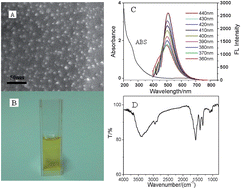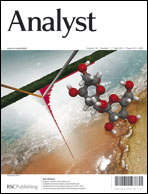Electrogenerated chemiluminescence detection of trace level pentachlorophenol using carbon quantum dots†
Abstract
Pentachlorophenol (PCP) is an environmental pollutant of serious concern due to its high toxicity and long persistence property. Fast and sensitive detection of PCP is therefore of great interest. In this work, carbon quantum dots (QDs) are synthesized by hydrothermal reaction, and characterized by fluorescence spectrophotometer, fourier transform infrared (FT-IR) spectroscopy, UV/vis/NIR spectrophotometer and scanning electron microscopy (SEM). The carbon QDs show stable and intensive electrogenerated chemiluminescence (ECL) in the presence of the coreactant S2O82−. Under the scanning potential of −1.2 to 0.5 V, PCP reacts with the excited C˙−, resulting in a decrease in ECL. The detection of trace level PCP is therefore achieved using the carbon QDs and Pt working electrode. Parameters that may affect the ECL intensity including the pH of solution, ionic strength, concentrations of coreactant and carbon QDs are optimized. Under the optimal conditions, a detection limit of 1.3 × 10−12 g L−1 is achieved with a linear range of 10 pg L−1∼1.0 μg L−1.

- This article is part of the themed collection: 2013's Top 25 most read Analyst articles

 Please wait while we load your content...
Please wait while we load your content...